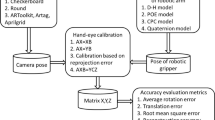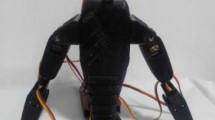Abstract
This paper presents the control of a robotic system based on a data-driven model. The components of the robotic system are a redundant robot and a motion capture system, both considered as a class of nonlinear discrete Multi-Input and Multi-Output system. The strong tracking Kalman filter algorithm approximates the Jacobian matrix of an equivalent model for the robotic system considering only the input and output on-line data. Moreover, a type of proportional controller based on the estimated Jacobian matrix for the robot’s end-effector is designed. The Lyapunov stability analysis guarantees the convergence of the equivalent model and the control law. The estimation and control approach are validated with thorough experimental results.
















Similar content being viewed by others
References
Chen F, Selvaggio M, Caldwell D (2018) Dexterous grasping by manipulability selection for mobile manipulator with visual guidance. IEEE Trans Industr Inform 15(2):1202–1210
Alonso J, Knepper R, Siegwart R, Rus D (2015) Local motion planning for collaborative multi-robot manipulation of deformable objects. In: 2015 IEEE international conference on robotics and automation (ICRA), pp 5495–5502. IEEE
Deegan P, Grupen R, Hanson A, Horrell E, Ou S, Riseman E, Sen S, Thibodeau B, Williams A, Xie D (2008) Mobile manipulators for assisted living in residential settings. Auton Robot 24 (2):179–192
Sharma S, Kraetzschmar GK, Scheurer C, Bischoff R (2012) Unified closed form inverse kinematics for the kuka youbot. In: ROBOTIK 2012; 7th German conference on robotics, pp 1–6. VDE
Gracia L, Solanes JE, Muñoz-Benavent P, Miro JV, Perez-Vidal C, Tornero J (2018) Adaptive sliding mode control for robotic surface treatment using force feedback. Mechatronics 52:102–118
Mohammad AEK, Hong J, Wang D (2018) Design of a force-controlled end-effector with low-inertia effect for robotic polishing using macro-mini robot approach. Robot Comput Integr Manuf 49:54–65
Buss S (2004) Introduction to inverse kinematics with jacobian transpose, pseudoinverse and damped least squares methods. IEEE J Robot Autom 17(1-19):16
Lee K-K, Buss M (2007) Obstacle avoidance for redundant robots using jacobian transpose method. In: 2007 IEEE/RSJ international conference on intelligent robots and systems, pp 3509–3514. IEEE
Spong M, Vidyasagar M (1987) Robust linear compensator design for nonlinear robotic control. IEEE J Robot Autom 3(4):345–351
Treesatayapun C (2013) Discrete-time direct adaptive control for robotic systems based on model-free and if–then rules operation. Int J Adv Manuf Technol 68(1-4):575–590
Carreon A, Baltazar A, Treesatayapun C (2017) Development of a model-free force controller for soft contact of an ultrasonic test probe. Int J Adv Manuf Technol 90(9-12):2839–2847
Treesatayapun C (2013) Grasping force controller for parallel grip with fuzzy rules emulated networks. Int J Adv Manuf Technol 68(1-4):45–55
Li M, Kang R, Branson DT, Dai JS (2018) Model-free control for continuum robots based on an adaptive kalman filter. Trans Mechatron 23(1):286–297
Huang J, An H, Lang L, Wei Q, Ma H (2020) A data-driven multi-scale online joint estimation of states and parameters for electro-hydraulic actuator in legged robot. IEEE Access 8:36885–36902
Chen D, Zhang Y, Li S (2017) Tracking control of robot manipulators with unknown models: a jacobian-matrix-adaption method. IEEE Trans Industr Inform 14(7):3044–3053
Hou Z, Zhu Y (2013) Controller-dynamic-linearization-based model free adaptive control for discrete-time nonlinear systems. IEEE Trans Industr Inform 9(4):2301–2309
Hou Z, Chi R, Gao H (2016) An overview of dynamic-linearization-based data-driven control and applications. IEEE Trans Ind Electron 64(5):4076–4090
Zen Z, Cao R, Hou Z (2018) Mimo model free adaptive control of two degree of freedom manipulator. In: 2018 IEEE 7th data driven control and learning systems conference (DDCLS), pp 693–697. IEEE
Guo Y, Hou Z, Liu S, Jin S (2019) Data-driven model-free adaptive predictive control for a class of mimo nonlinear discrete-time systems with stability analysis. IEEE Access 7:102852–102866
Hou Z, Jin S (2011) Data-driven model-free adaptive control for a class of mimo nonlinear discrete-time systems. IEEE Trans Neural Netw 22(12):2173–2188
Dietrich A, Ott C, Albu-Schäffer A (2015) An overview of null space projections for redundant, torque-controlled robots. Int J Robot Res 34(11):1385–1400
Author information
Authors and Affiliations
Corresponding author
Additional information
Publisher’s note
Springer Nature remains neutral with regard to jurisdictional claims in published maps and institutional affiliations.
Appendices
Appendix 1: Proof of the Theorem 2.1
The Lyapunov function in terms of the updated estimation error in the modelling is:
the change in the Lyapunov function is:
the change in the Lyapunov function in terms of the change of estimation error Δ𝜖(k + 1) from Eq. 23 is:
substituting the estimation error in the change in Lyapunov function:
according to Corollary I \(H(k) K_{F}(k)\triangleq I\); therefore, Eq. 51 becomes:
Equations 48 and 52 satisfy that the Lyapunov conditions V𝜖(k + 1) > 0 and ΔV𝜖(k + 1) < 0; hence, we can conclude that the estimation error 𝜖(k) converges to zero while \(k \rightarrow \infty \).
Appendix 2: Proof of the Theorem 3.1
The Lyapunov function is defined:
the change in the Lyapunov function is:
the change in the Lyapunov function in terms of the change in the error:
from the position error definition in Eq. 30, and χd(k + 1) = χd(k) + Δχd(k + 1), it is obtained the next equation:
where \(J_{A}^{*}(k)=\hat {J}_{A}(k)+\epsilon (k)\). The change in the error Δe(k + 1) includes the estimated Jacobian matrix \(\hat {J}_{A}(k) \) and the residual error of the model 𝜖(k) in Eq. 4:
According to [21], the generalized pseudo-inverse matrix \(\hat {J}_{A}^{\dagger }(k)\) of a full row rank matrix \(\hat {J}_{A}(k) \in \mathbb {R}^{m \times n}\) with m < n satisfies the next criterion \(P_{k}=J_{A}^{*}(k) \hat {J}_{A}^{\dagger }(k)\), which is a positive definite matrix considering (42).
where \( {\varOmega }_{k}=\left [P_{k}C_{k} -I\right ]{\varDelta }\chi _{d}(k+1)\leq {\varGamma }_{1}\) if \({\mathscr{B}}_{1} \triangleq P_{k}C_{k} -I\), \({\varGamma }_{1} \triangleq \lambda _{max}({\mathscr{B}}_{1}) \parallel {\varDelta }\chi _{d}(k+1) \parallel \). Substituting the change in control error into the change in the Lyapunov function:
where the terms in function of Ωke(k) are undefined in sign, to cancel them, we need to fulfill the following condition:
according to Corollary II Pk ≈ I when 𝜖(k) ≈ 0, by design it is chosen that \(\alpha =I C_{k}^{-1}\). Therefore, \(\parallel {\varOmega }_{k} {{\varOmega }_{k}^{T}}\parallel ^{2} \leq {\varGamma }_{2}\) if \({\mathscr{B}}_{2}=P_{k}\alpha ^{-1}-I\), \({\varGamma }_{2} \triangleq \left [ \lambda _{\max \limits }({\mathscr{B}}_{2}) \parallel {\varDelta }\chi _{d}(k+1) \parallel ^{2} \right ]\). Then, the stability condition should satisfy:
the requirement for the stability condition is ΔV (k + 1) < 0. Considering that \(C_{k}\in \mathbb {R}^{3 \times 3} \) is a diagonal matrix which contains varying time parameters Ckx, Cky, and Ckz and \(\alpha \in \mathbb {R}^{3 \times 3}\) is a diagonal matrix which contains constant parameters αx, αy, and αz, we can define the selection of α as a constant regarding the performance of the parameters Ckx, Cky, and Ckz in Fig. 17.
Therefore, \(\alpha =I C_{k}^{-1}\) when 𝜖(k) ≈ 0 and \(e(k) \rightarrow 0\) and it is possible to obtain the lower and the upper bounded constants for the values in the diagonal matrix α as follows:
The selected values used for αx, αy, and αz in Tables 1 and 2 are in agreement for the condition in Eq. 62, and αx, αy, and αz have lower values for the experimental conditions to prevent damages in the robot actuators. Once the parameters in the diagonal matrix α are established, we can find the value of ρx, ρy, and ρz by the next expressions:
now, it is possible to select the values for ρx, ρy, and ρz considering that Ck fulfills the conditions \(\alpha =I C_{k}^{-1}, \) \(e(k) \rightarrow 0\), and 𝜖(k) ≈ 0 and also that the values of α satisfy the condition in Eq. 62:
the selected values for ρx, ρy, and ρz in Tables 1 and 2 are in agreement for the condition in Eq. 64. Considering \(\alpha =IC_{k}^{-1} \) and the term \(I- \frac {1}{2} C_{k} \alpha \) must be positive to fulfill the Lyapunov stability condition ΔV (k + 1) < 0 in Eq. 61:
therefore, the next term satisfies the stability condition:
and substituting \(\alpha =IC_{k}^{-1}\) in the condition (66), it is obtained:
Then, the Lyapunov condition ΔV (k + 1) is satisfied. It is possible to fulfill according to Eq. 61, where the term \(\frac {1}{2} {\varOmega }_{k}{{\varOmega }_{k}^{T}}\) is bounded, the term − Ckαe(k)eT(k) remains negative, by choosing \(\alpha \leq IC_{k}^{-1}\), then the result is the positive definite matrix \( \frac {1}{2}I\). Therefore, Eq. 61 becomes:
By construction V (k + 1) > 0, see Eq. 53; moreover, according to Eq. 68, ΔV (k + 1) < 0 in a vicinity of the origin. Therefore, the e(k) approaches to a compact set also near to a vicinity of the origin. With this, it is conclude that the control (42) stabilizes the robot system in Eq. 6.
Rights and permissions
About this article
Cite this article
Gómez, J., Treesatayapun, C. & Morales, A. Data-driven identification and control based on optic tracking feedback for robotic systems. Int J Adv Manuf Technol 113, 1485–1503 (2021). https://doi.org/10.1007/s00170-020-06377-5
Received:
Accepted:
Published:
Issue Date:
DOI: https://doi.org/10.1007/s00170-020-06377-5





